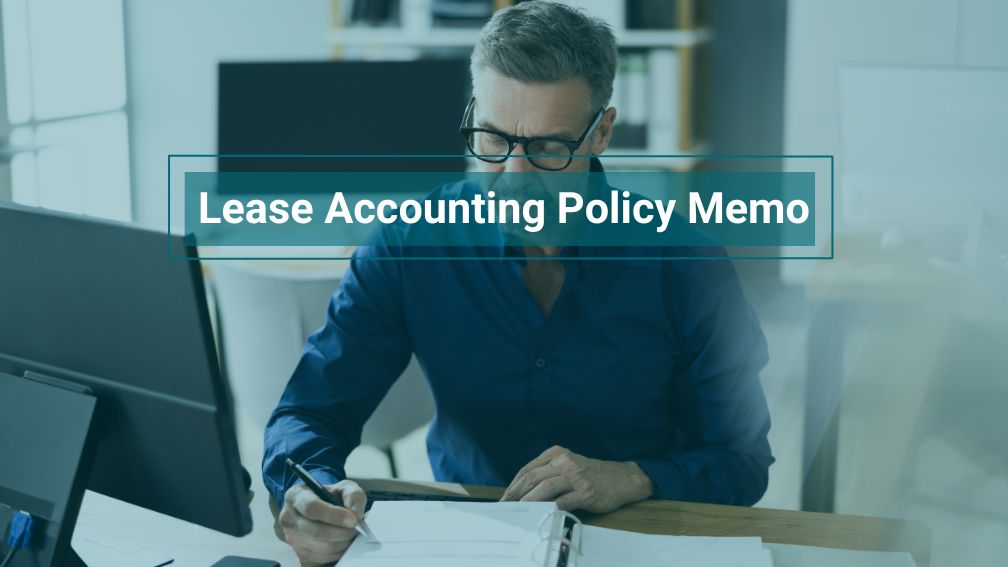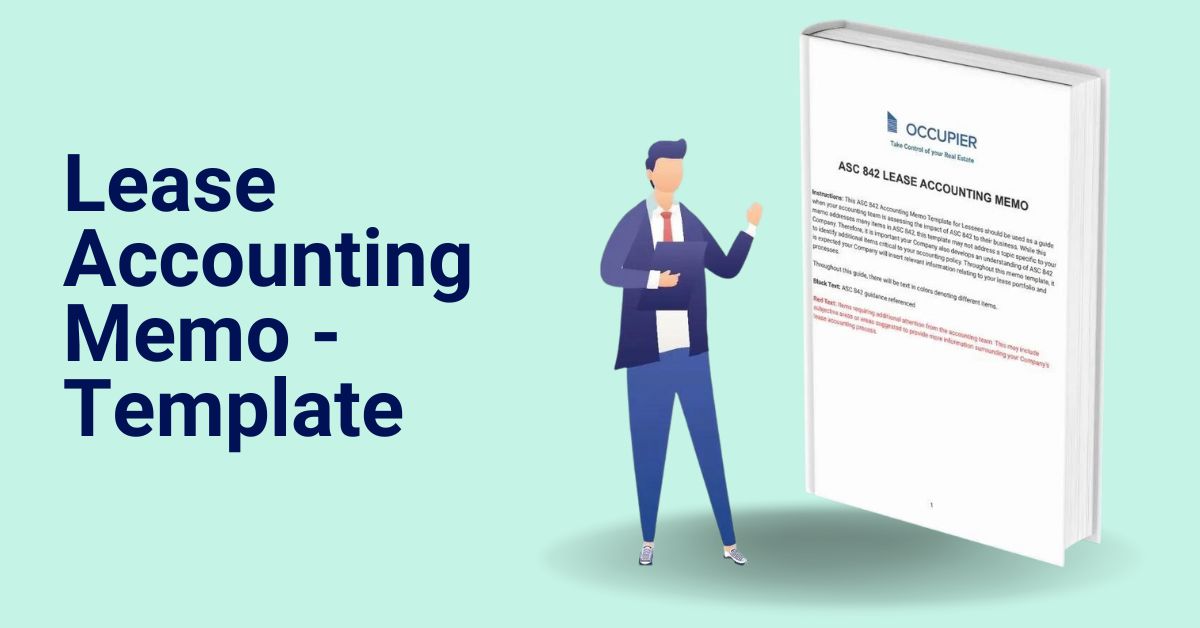How to Write a Lease Accounting Policy Memo
Last Updated on June 22, 2023 by Morgan Beard
Among the many changes introduced with ASC 842 and IFRS 16, the new lease accounting standards, is the lease accounting policy memo. At a high level, this is a document that outlines an organization’s policies and procedures for lease accounting.
A good policy memo goes into great detail and serves as a guide for all lease-related activities, including:
- How the business will recognize leases
- How the business will measure leases
- How to disclose leases in financial statements
- And many other points
Both FASB ASC 842 and IFRS 16 require lessees to recognize most leases on their balance sheets as right-of-use (ROU) assets and lease liabilities, which is a significant departure from previous accounting standards. A comprehensive lease accounting policy memo ensures your organization determines lease classifications correctly, recognizes ROU assets, discount rates, initial direct costs and more.
Occupier’s latest guide walks you through how to write the best lease accounting policy memo for your organization, from preparing to write thorough policy memo implementation.
Preparing to Write a Lease Accounting Policy Memo
Before you can begin writing, the first important step is researching either ASC 842 (for American companies) or IFRS 16 (international businesses). Ensure that your lease accountants have a thorough understanding of the new applicable standard.
Be sure to keep up with any amendments or interpretations issued by the accounting standards bodies. Most organizations have gone through their first audits under the new standards and are now aware of industry-specific changes and have made adjustments where necessary.
You must decide how your accounting team will classify operating leases and finance leases. Properly classifying leases (and embedded leases found in other contracts) is critical to following the new standards.
List the criteria you will use for lease identification and describe the classification process. This information, along with your company’s guidelines for short-term lease exemptions, should all be described in the final policy memo, so it’s best to work out these details ahead of time.
Components to Include in the Lease Accounting Policy Memo
After you have defined your lease classification standard and gathered the lease stakeholders’ feedback, you can work on some critical components of the lease accounting policy memo.
Systems & Teams
Beyond your accounting group, you should involve other departments that work with leases or leased assets in your organization. This frequently includes your legal, operations, and maintenance teams to understand their perspective on your company’s leases. Collaboration with these stakeholders ensures that their input and insights will be incorporated into the policy memo. Allocate any research responsibilities to the appropriate team members and set deadlines for turning in their findings.
ASC 842 Key Terms
Start by establishing the method for calculating your operating lease liabilities, finance lease liabilities and ROU assets. Provide detailed descriptions of crucial lease accounting tasks, such as determining a discount rate. In that process, you need to consider factors like the lessee’s incremental borrowing rate or the rate implicit in the lease. You’ll need to describe this and other processes in detail.
Determination of Asset Classes
At the ASC 842 transition date, there are transition elections available to be applied on an entity- wide basis for all leases. Certain accounting policy elections can be applied based on the class of underlying assets. Within this section, describe if the Company will segregate the lease portfolio into separate classes of underlying assets and how the Company made this determination.
Next, address the handling of lease modifications and reassessments. Provide detailed guidelines for how you will reassess lease terms or allocate lease payments when there are significant changes to a lease contract. Specifying the criteria and steps involved in these assessments is essential for consistency within departments and across your organization.
Throughout the policy memo, incorporate examples and illustrations to enhance understanding and reinforce the application of the policies. Reference the relevant sections of ASC 842 or IFRS 16 to align the policies with the requirements and principles outlined in the standards.
Financial Statement Impact
Specify where and how lease-related balances should appear in your financial statements like your balance sheet and income statement. Clearly define presentation requirements for lease liabilities, ROU assets, and any associated amortization or interest expenses. This ensures that the appropriate line items or captions are used and that lease-related balances are accurately captured on the balance sheet and other documents.
The policy memo should also list any required disclosures as required by the new standards. Depending on the nature of your business, this may include:
- Lease commitments
- Maturity analysis of lease liabilities
- Any unique leasing arrangements
- Variable lease payments
Disclosure requirements should be clearly explained, specifying the necessary content and formatting method.
Your lease accounting policy memo should also determine the frequency and format of lease-related reporting. This involves establishing the reporting frequency—such as quarterly or annual reporting—and the format in which lease-related information should be presented.
Another component to consider is any specific reporting requirements required by organizational policy or regulatory requirements. Your policy memo should also cover how your company will disclose and report these special requirements.
Writing a Clear and Concise Lease Accounting Policy Memo
Your lease accounting policy memo needs to be clearly written and concisely defined to ensure it’s understood by anyone who may read it, from lease accountants to internal stakeholders and auditors.
Organize your memo with logical, consecutive formatting. A policy memo that all departments can understand should follow these directives:
- Include heading and contact information: Create a clear, informative heading identifying the memo’s purpose. This heading should be followed by relevant contact information to facilitate communication with the responsible individuals.
- Insert the date and a subject line briefly describing the memo’s topic: This gives readers the necessary context and helps them locate the memo quickly and completely.
- Use sequential numbering or bullet points that clearly separate the main sections of the memo: You want to ensure a clear and structured presentation of information, allowing readers to navigate the policy memo efficiently.
- Use clear, precise language with examples or images clarifying concepts: Refrain from using accounting jargon or terms that a general reader won’t understand.
Remember diversity when considering who might one day read your policy memo.
Lease Accounting Policy Memo – Free Download
This ASC 842 Accounting Memo Template for Lessees should be used as a guide when your accounting team is assessing the impact of ASC 842 to their business. While this memo addresses many items in ASC 842, this template may not address a topic specific to your Company. Therefore, it is important your Company also develops an understanding of ASC 842 to identify additional items critical to your accounting policy. Throughout this memo template, it is expected your Company will insert relevant information relating to your lease portfolio and processes.
Implementing and Monitoring the Lease Accounting Policy Memo
Once you’ve completed a final draft of the memo, you can take the final steps toward implementation.
Obtain approval from relevant internal parties
You’ll need the internal stakeholders who worked on the policy memo to sign off on the document. Give them a chance to review and make sure their input has been adequately incorporated.
Revisions based on their feedback may be necessary to address any concerns or suggestions they may have. This collaborative process ensures that the lease accounting policy memo receives appropriate approval and support from key organizational stakeholders.
Circulate to other stakeholders, like lessees and lessors
You should next distribute the memo to others involved in lease accounting processes, including lessees and lessors.
Ensuring that all relevant stakeholders receive the finalized memo promotes consistent understanding and adherence to the lease accounting policies outlined in the document.
Schedule periodic evaluations and updates
You can expect the new lease accounting standards to evolve over time, requiring periodic evaluations and updates to your policy memo. Establish a schedule for conducting these evaluations, such as one or twice per year, and incorporate any necessary updates or revisions to reflect changes in lease accounting requirements. This proactive approach ensures that the lease accounting policy remains up-to-date and aligned with current standards and regulations.
Occupier Simplifies the Lease Accounting Process
Creating a lease accounting policy memo is a requirement for today’s lease accounting standards. It provides the foundation for your organization’s ASC 842 or IFRS 16 implementation. If the policy memo lacks anything or provides incorrect direction, you can expect trouble down the road. It’s smart to get it right before implementation.
If you’d like a head start, feel free to download the free lease accounting memo template from Occupier. It’s just one of the many tools we make available to help organizations navigate modern lease accounting.
Our innovative software simplifies the entire lease accounting process. Request a demo to see why Occupier is the right lease accounting choice for you.

